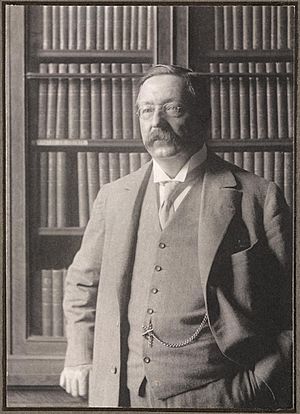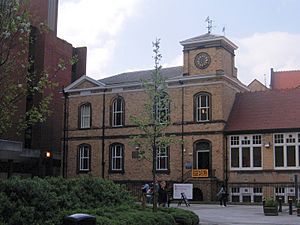William Henry Perkin Jr. facts for kids
Quick facts for kids
William Henry Perkin Jr.
|
|
|---|---|
 |
|
| Born | 17 June 1860 |
| Died | 17 September 1929 (aged 69) Oxford, England
|
| Nationality | English |
| Alma mater | Royal College of Science University of Würzburg University of Munich |
| Known for | Perkin triangle |
| Awards | Longstaff Prize (1900) Davy Medal (1904) Royal Medal (1925) |
| Scientific career | |
| Institutions | Heriot-Watt College Victoria University of Manchester University of Oxford |
| Doctoral advisor | Adolf von Baeyer |
| Doctoral students | Robert Robinson Walter Haworth Chaim Weizmann Victor Trikojus |
William Henry Perkin Jr. (born June 17, 1860 – died September 17, 1929) was an English chemist. He was especially known for his important work in organic chemistry. This field of chemistry studies chemicals found in living things. He focused on breaking down natural organic compounds.
William Henry Perkin Jr. was also a Fellow of the Royal Society (FRS) and a Fellow of the Royal Society of Edinburgh (FRSE).
Contents
Early Life and Education
William Henry Perkin Jr. was born in Sudbury, England. His father, Sir William Henry Perkin, was famous for starting the aniline dye industry. This industry made colorful dyes for fabrics. William Jr.'s brother, Arthur George Perkin, also became a chemistry professor.
William Jr. went to the City of London School. Later, he studied at the Royal College of Science in London. He also studied in Germany at the universities of Würzburg and Munich. In Munich, he worked with a famous chemist named Adolf von Baeyer.
From 1883 to 1886, he taught at the University of Munich. He stayed friends with Baeyer for many years.
In 1887, he came back to Britain. He became a chemistry professor at Heriot-Watt College in Edinburgh, Scotland. Today, a building at the college is named after him.
Working in Manchester
In 1892, Perkin became the head of organic chemistry at Owens College in Manchester, England. He held this job until 1912. During his time there, he was a great teacher and researcher. Many students came from all over Europe to study with him.
He helped create a famous school of organic chemistry in Manchester. This was possible because he helped design new laboratory buildings. These labs were similar to those built by his old teacher, Baeyer, in Munich. A chemist and businessman named Edward Schunck donated money for another lab building and a library.
Many bright students studied at Owens College while Perkin was there. These included Frank Lee Pyman, Robert Robinson, and Walter Haworth. Robert Robinson later won a Nobel Prize in chemistry.
Teaching at Oxford
In 1912, Perkin moved to Oxford University. He became the Waynflete Professor of Chemistry. He stayed in this important role until 1929. When he first arrived, several colleges at Oxford had their own small labs.
Perkin worked to build new and much larger laboratories. These were called the Dyson Perrins Laboratory. For the first time in England, students studying chemistry at Oxford had to do research as part of their degree. This helped train many new scientists.
His Published Work
Perkin wrote many scientific papers. These were published in the Transactions of the Chemical Society. His early work looked at how to make and understand different types of hydrocarbons. These are basic chemical compounds.
His research also led to making many terpenes and chemicals from the camphor group. He also studied various alkaloids and natural dyes. Besides his scientific research, Perkin also worked closely with the chemical industry.
With his brother-in-law, Professor Frederick Kipping, Perkin wrote several textbooks. These books covered practical chemistry, inorganic chemistry, and organic chemistry. Their book Organic Chemistry came out in 1899.
Awards and Recognition
Perkin received many honors for his work. He was chosen as a Fellow of the Royal Society in 1890. The Royal Society gave him the Davy Medal in 1904 and the Royal Medal in 1925.
He was also the president of the Chemical Society from 1913 to 1916. The Chemical Society awarded him their Longstaff Medal in 1900. In 1910, the University of Edinburgh gave him an honorary degree.
Later Life
In 1887, William Henry Perkin Jr. married Mina Holland. They did not have any children. His two brothers-in-law, Arthur Lapworth and Frederick Kipping, were also well-known scientists.
William Henry Perkin Jr. passed away in Oxford on September 17, 1929. He is buried in Wolvercote Cemetery in Oxford.
Sources
 This article incorporates text from a publication now in the public domain: "Perkin, William Henry". Encyclopædia Britannica (12th) 32. (1922). London & New York: The Encyclopædia Britannica Company.
This article incorporates text from a publication now in the public domain: "Perkin, William Henry". Encyclopædia Britannica (12th) 32. (1922). London & New York: The Encyclopædia Britannica Company.


